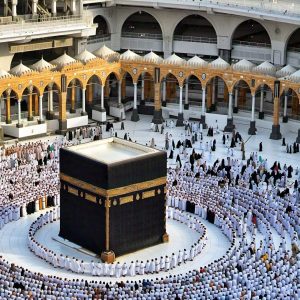HAJJ PILGRIMAGE: A JOURNEY OF SPIRITUAL DEVOTION

Hajj, one of the five pillars of Islam, is a sacred pilgrimage to the holy city of Mecca that holds immense historical and spiritual significance.
This journey, undertaken by millions of Muslims worldwide, is a testament to the unity and devotion of the Islamic community.
WHEN WAS THE FIRST HAJJ?
The origin of Hajj dates back to 2,000 BC, when Prophet Ibrahim (AS) and his son, Prophet Ismail (AS), constructed the Holy Kaaba as commanded by Allah SWT. However, the first official pilgrimage (Hajj) took place after Prophet Muhammad (PBUH) and his companions migrated to Madinah and succeeded in conquering Makkah in 10 AH (632 CE).
This historic event is also known as the Farewell Hajj, the Last Pilgrimage, and Hajjat-ul-Wida.
WHAT IS THE PURPOSE OF HAJJ?
Hajj is obligatory for financially and physically able Muslims, symbolizing unity, devotion, and submission to Allah’s will.
The pilgrimage offers a chance to wipe clean past sins and start anew, as the Prophet Muhammad (PBUH) said:
“When a believer returns home after performing Hajj, he is as he was on the day his mother gave birth to him” (Sahih Bukhari).
Hajj provides pilgrims with inner purity, tranquility of heart, and a deeper understanding of Allah’s creations.
WHY IS HAJJ IMPORTANT IN ISLAM?
Hajj is a fundamental aspect of Islam, emphasizing the importance of worship, unity, and compassion.
The Quran states:
The first House established for mankind was that at Bakkah—blessed and a guidance for the worlds” (Holy Quran 3: 96-97). Hajj brings Muslims together, fostering a sense of community and spiritual growth.
HOW LONG IS HAJJ?
The obligation of Hajj involves a series of rituals that take place in Makkah over a period of five to six days.
Muslims from worldwide start arriving in Makkah, Saudi Arabia, from the 1st of Dhul-Hijjah till the 7th of Dhul-Hijjah.
The main rituals of Hajj take place between the 8th of Dhul-Hijjah and the 12th of Dhul-Hijjah.
DIFFERENT TYPES OF HAJJ
There are three types of Hajj:
1. Hajj Tamattu: Performed during the days of pilgrimage (1 to 10 Dhul-Hijjah), accompanied by Umrah and Qurbani (sacrifice).
2. Hajj Qiran: Umrah followed by Hajj, requiring Qurbani.
3. Hajj Ifrad: Without Qurbani, performing Sai for Hajj and Tawaf al-Qudum.
THE RITUALS OF HAJJ
The Hajj rituals are rooted in the legacy of Prophet Ibrahim (AS) and his family. Key components include:
1. Ihram: A state of spiritual purity.
2. Tawaf: Circling the Kaaba seven times counterclockwise.
3. Sa’i: Walking between Safa and Marwa.
4. Standing at Arafah: Symbolizing judgment day.
5. Muzdalifah: Collecting pebbles for stoning the Jamarat.
6. Stoning the Devil: Rejecting temptation and evil.
7. Eid al-Adha: Celebrating Prophet Ibrahim’s willingness to sacrifice his son Ismail.
THE SPIRITUAL IMPACT OF HAJJ
Hajj offers pilgrims a chance to:
1. Renew their commitment: To Allah and their faith.
2. Seek forgiveness: For past sins and mistakes.
3. Cultivate empathy: For those in need and suffering.
4. Experience unity: With the global Muslim community.
THE REWARDS OF HAJJ
The rewards of Hajj are immense. The Prophet Muhammad (PBUH) said: “Umrah after Umrah is an expiation for what is between them” (Sahih Bukhari). Muslims believe that Hajj can lead to forgiveness of sins, increased spiritual rewards, and a deeper connection with Allah.
In conclusion, Hajj is a sacred pilgrimage that holds immense historical and spiritual significance, offering pilgrims a chance to deepen their connection with Allah and cultivate a stronger sense of community and spiritual growth.

